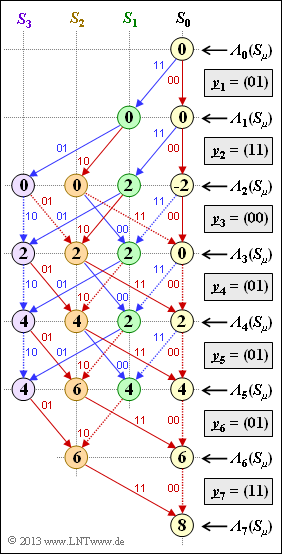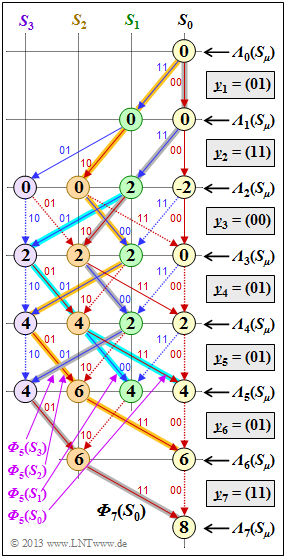Exercise 3.11: Viterbi Path Finding
One result of "Exercise 3.10" was adjacent trellis evaluation in terms of metrics ${\it \Lambda}_i(S_{\mu})$. At all decoding steps $i$ the (in general) $2^m = 4$ metrics were determined, selecting for each node the larger of two comparison values. The branch with the lower value was discarded. One can recognize discarded branches in the graph by dotted lines.
Otherwise, the same conditions apply as for "Exercise 3.10". For example, also in the adjacent graph, a red arrow indicates the information bit $u_i = 0$ and a blue arrow stands for $u_i = 1$.
In the present exercise we consider the second and important part of the Viterbi–algorithm, namely the search for the "surviving" paths ${\it \Phi}_i(S_{\mu})$. These are at time $i$ in state $S_{\mu}$ with $\mu \in 1, 2, 3, 4$. The search is best organized in the backward direction (i.e., from bottom to top in the graph).
At the end time (in the example $i = 7$) there is only one surviving path ${\it \Phi}_7(S_0)$ due to termination. From this it is possible to extract:
- the code sequence selected by the decoder $\underline{z}$ ⇒ highest possible probability ${\rm Pr}(\underline{z} = \underline{x})$,
- the associated information sequence $\underline{v}$ with the greatest possible probability ${\rm Pr}(\underline{v} = \underline{u})$.
A decision at an earlier time, for example at $i = 5$, does not always satisfy the maximum likelihood criterion. Here there are four surviving paths ${\it \Phi}_5(S_0), \hspace{0.05cm}\text{ ...} \hspace{0.1cm} , \ {\it \Phi}_5(S_3)$, which at time $i = 5$ are in states $S_0, \hspace{0.05cm}\text{ ...} \hspace{0.1cm} , \ S_3$ end.
- One of these four paths is certainly part of the maximum likelihood path, which is the best possible path for $i → ∞$ $($at termination significantly earlier, here at $i = 7)$ .
- But if a constraint decision is to be made already at time $i = 5$ one usually chooses the path ${\it \Phi}_5(S_{\mu})$ with the largest metric at that time ${\it \Lambda}_5(S_{\mu})$.
Hints:
- This exercise belongs to the chapter "Decoding of Convolutional Codes".
- Reference is made in particular to the page "Evaluating the trellis in the error-free case –Path finding".
Questions
Solution
- Unambiguously find the surviving path by searching backwards, i.e., from node ${\it \Lambda}_7(S_0)$ to node ${\it \Lambda}_0(S_0)$.
- Using the code sequences $(00, \, 01, \, 10$ or $11)$ given at the transitions, we obtain in the forward direction the result according to Proposition 2 ⇒ ${\it \Phi}_7(S_0)$:
- $$\underline{z} = \big (00\hspace{0.05cm}, 11\hspace{0.05cm}, 10\hspace{0.05cm}, 00\hspace{0.05cm}, 01\hspace{0.05cm}, 01\hspace{0.05cm}, 11\hspace{0.03cm} \big ) \hspace{0.05cm}.$$
- Do not reach the final node ${\it \Lambda}_7(S_0)$ along the other paths.
(2) By comparing the code sequence $\underline{z}$ selected in subtask (1) with the received sequence
- $$\underline{y} = \big (01\hspace{0.05cm}, 11\hspace{0.05cm}, 00\hspace{0.05cm}, 01\hspace{0.05cm}, 01\hspace{0.05cm}, 01\hspace{0.05cm}, 11\hspace{0.03cm} \big )$$
one detects three bit errors at positions 2, 5, and 8.
- If a code sequence $\underline{x} ≠ \underline{z}$ was sent, there can of course be more.
- Because of the final value ${\it \Lambda}_7(S_0) = 8$ or ${\it \Gamma}_7(S_0) = 3$ – see "Exercise 3.10" – but one can assume that a correct decision ⇒ $\underline{z} = \underline{x}$ has been made.
(3) Correct is proposed solution 1:
- From the colors of the surviving path – red represents $u_i = 0$ and blue represents $u_i = 1$ – one can see the correctness of solution proposal 1: red – blue – red – blue – blue – red – red.
- It should be noted that the actual information sequence $\underline{u}$ is only of length $L = 5$.
- Only by termination one arrives at the total length $L' = L + m = 7$.
(4) At time $i = 6$ there are still two surviving paths. A decision could be forcibly made based on the larger metric. However, because of ${\it \Lambda}_6(S_0) = {\it \Lambda}_6(S_2) = 6$ this is not possible in our example ⇒ No.
(5) The graph shows that all proposed solutions are correct. The paths are labeled ${\it \Phi}_5(S_0)$, ... , ${\it \Phi}_5(S_3)$.
(6) The constraint decision at time $i = 5$ would select the path with the largest metric ${\it \Lambda}_5(S_{\mu})$, i.e., the path ${\it \Phi}_5(S_2)$ corresponding to proposition 3.
(7) Based on our solution to subtask (1), the path ${\it \Phi}_5(S_3)$ according to proposition 4 would have been the better choice.
- This is part of the path ${\it \Phi}_7(S_0)$.
- At the time $i = 5$, however, there is still nothing in favor of this choice.
- The (ultimately correct) path is only highlighted by the two termination bits.

